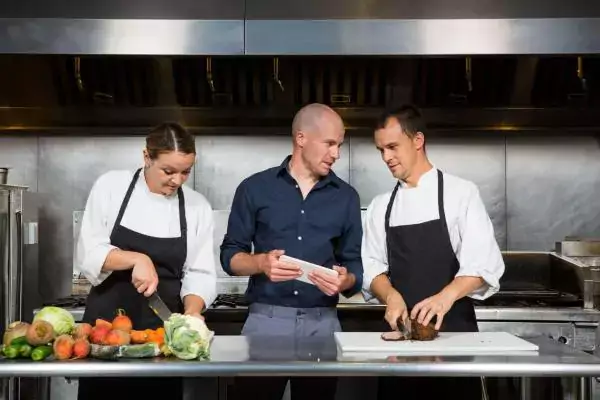When you think of the culture of your typical American casual dining restaurant, what do you think of? For a lot of people, myself included, it’s Jennifer Aniston’s character in the movie “Office Space.” If you haven’t already noticed, that’s a favorite movie for the Zenput team, simply for the fact that it holds universal truths about work environments, which we aim to improve.
There’s that scene where Aniston gets reprimanded by the restaurant manager for not wearing enough “flair”—the buttons that supposedly show her personality. According to the director, “Office Space” made TGI Fridays get rid of “flair,” because customers started making fun of the servers—the intersection of art and life! It’s a silly idea that “flair” could improve a server’s mood or make a restaurant culture more fun. It reminds me of when a company has a “Fun Committee.” Just because you tack “fun” onto something, doesn’t mean your employees enjoy their environment.
We already know that the restaurant industry has high turnover. But it’s troubling when the latest statistics show that turnover rates have been pushing higher. An improving economy could mean more day-to-day, month-to-month operational challenges for managers. It could also mean increased competition because consumers have more disposable income and restaurants are competing for their dollars.
Case in point in this market segment: Ruby Tuesday just announced the closure of 95 restaurants.
Managers in casual restaurants have enough to worry about lately. How can employee training and culture—the umbrella of employee engagement—improve? Can they improve to the point where turnover decreases?
Using Processes That Work
I recently read a fascinating account of Chili’s employee training procedures. This article was a genius pitch. Journalist Daniel Riley, who happens to be a former “Chilihead”, asked his former employer if he could go behind the scenes of the team that trains managers for restaurant openings. It’s a detailed account of what makes Chili’s successful today and, quite possibly, what has made this brand stand the test of time. What I took away from the story was an affirmation of what I’ve learned at Zenput: Processes that encourage employees to think in “real time” and to think on their feet really do work. Implementing time-tested, best practices works. Following up on site to make sure best practices are being implemented also works. It all just works at Chili’s. They have a formula for success that’s just as flavorful as their Presidente margarita—and even that has a designated 25 shakes! This is my favorite line of Riley’s article: “At Chili's, though, kids who start as dishwashers can wind up on an all-expenses-paid adventure to Malaysia because they did a simple job better than anyone else and had the right attitude about it the whole way. At Chili's, life gets bigger and better by fifteen new restaurants a year.” And do you know the No. 1 fundamental of working at Chili’s? Everyone pay attention: It’s having fun!Can you create an environment where people want to stay, if not for a career (like many do in Chili’s), but to return on their college breaks?
Recognizing good employee effort and rewarding that effort isn’t a new idea in this industry. But doing it in a consistent, measurable way is the true team effort—more so than an inspirational poster in the break room. Measuring the effectiveness of training can change a restaurant’s culture. And changing culture doesn’t just allow a brand to survive in a crowded market—it allows an organization to thrive.Subscribe to our blog
You are now subscribed!


